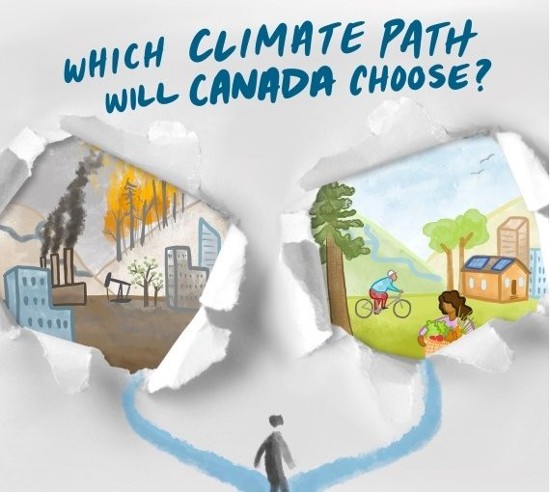There are six political parties vying for seats in Canada’s Parliament at next week’s election. In my first posting on the subject of climate change policy, I was able to get through about half of the Liberal Party’s plans should they be returned to government. In this posting, I will provide a summary of the remaining Liberal positions, comment and rate them (in italics). I’m a hard marker when it comes to rating climate change programs considering the existential threat the issue represents.
Liberal Party’s Climate Plan – Part 2
- Adapting to climate change impacts means offering homeowners grants of up to $5,000 and interest-free loans up to $40,000 for home retrofits. (Rating B: Why? Because in Canada’s largest cities many of its residents live in condominium apartments which are not included in the program. This oversight needs to be addressed because many of the buildings, including the one I live in, will need retrofits to become more climate change resilient.)
- A building and homes strategy that is focused on net-zero emissions to meet the 2050 zero-emissions target. This includes: development of a net-zero emissions building code national standard to be adopted by 2025; a move to electrification and away from fossil-fuel based heating systems with $250 million set aside for low-income Canadians to get off home-heating oil; using EnerGuide labelling to rate homes energy efficiency and use; instituting a Low-Carbon Canadian Building Materials Innovation Hub; making investments in forest industry transformation in pursuit of low-carbon building materials, and launching community-based net-zero homes initiatives to accomplish multiple concurrent retrofits. (Rating B+: Why not an A? Because much of this is aspirational and not fully costed.)
- A conservation program backed by $3.3 billion was allocated in the 2021 budget with a goal to conserve 25% of the country’s lands and waters by 2025 and 30% by 2030. The program focuses on Canada’s oceans, marine conservation areas, freshwater environments, national parks, forests and wildlife and includes: modernizing the Oceans Act to incorporate climate change impacts; investing in plastic cleanup of marine and freshwater environments; establishing 10 new national parks and 10 new national marine conservation areas within 5 years; establishing an Indigenous Guardians Network working with First Nations, Inuit, and Metis; developing a Canada Water Agency and updating the Canada Water Act to reflect climate change challenges and Indigenous rights; funding freshwater action plans for lakes and rivers across the country. (Rating A: More than aspirational, there is real money attached to these programs.)
- Implementing a zero-plastic-waste strategy to recycle 50% of all plastic packaging in Canada by 2030, and establishing a federal public registry that requires plastic producers and their downstream customers to report annually on amounts, types, and end-of-life management for these products including a $100 million fund to support innovation solutions for reuse and recycling of plastics; and subscribing to the Ocean Plastics Charter and working with countries to implement a global agreement on plastic pollution. (Rating C: Manufacturers and suppliers in Canada need to implement best circular economy practices to eliminate plastic from ending up in landfills. That means a public registry should do more than track these products, but should also establish caps on plastic use. Innovation investments should include alternative materials and packaging that is environmentally sustainable and non-polluting. This is where more than $100 million in funds is needed.)
- Implementing consumer protections that divert electronics from landfills by extending the life of electronics and home appliances through “right-to-repair” legislation with a 15% tax credit covering up to $500 on home appliance repairs performed by technicians, and amending the Copyright Act to prevent manufacturers from denying consumers the right to repair their purchases. (Rating A: This closely follows a similar initiative by the Biden administration in the U.S., and should reduce the amount of electronic waste which often contains environmentally toxic materials from being dumped in landfills.)
- Creating a circular food economy in Canada through the creation of a No-Waste Food Fund supporting the elimination, reduction, and repurposing of food waste to reduce the 2.2 million tons of household food waste that gets dumped annually into landfills, equivalent to 9.8 million tons of CO2 being added to the atmosphere. (Rating B+: No dollars have been assigned to this program so although aspirationally sound, it needs a funding commitment.)
- Finishing the job to end drinking water advisories on First Nations’ reserves. This ongoing embarrassment for the country includes a $6 billion commitment to make all necessary investments, and train First Nations staff, to end unsafe drinking water issues for First Nations. Of the 535 projects underway or completed on the books, there still remain 53 long-term drinking water advisories in effect for 34 First Nations. (Rating Incomplete: The Liberal government took on this mandate in 2015 to end advisories by 2020. That’s why I rate this policy incomplete.)
Overall, my rating of the Liberals climate change policy platform is a C+, largely because of what I consider weak aspirational targets set for reducing GHGs, a lack of commitment to fast-track the elimination of the burning of fossil fuels from the Canadian energy equation first with coal, then oil, and finally, natural gas, and not mentioned, the Liberal government’s Trans-Mountain Pipeline Expansion ownership and investment. This project will triple shipments of raw bitumen and condensates from the oil sands to the west coast for overseas and U.S. markets where the refined end products produced from it will end up contributing GHGs to the atmosphere and further global warming.
In our next posting, we look at the Conservative climate change platform, comment and rate it in comparison to what the Liberals have done and propose.
















